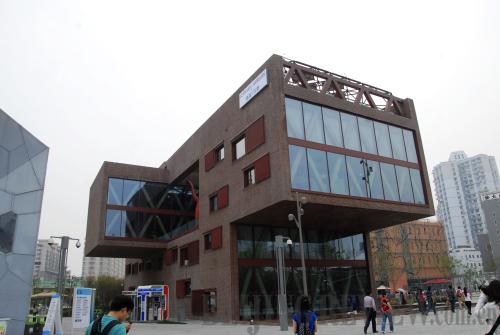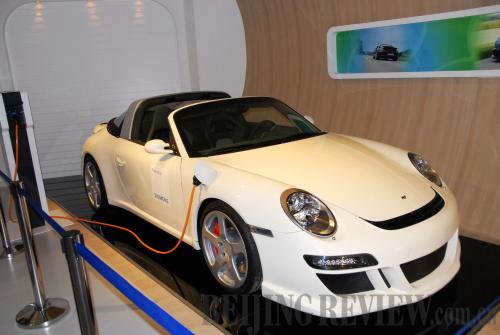|
|


ADVERTISEMENT
Buy Your own advertising
spaces!
.
Download Adobe Acrobat Reader to open [PDF] files.
Recent Visitors
Green Solutions
2010. 31 May
Siemens continues its traditional partnership with World Expos and offers its green solutions to Shanghai Illuminating the building, which has a vertical height of 66 meters, is not an easy  HAMBURG HOUSE: The house is located at the Urban Best Practices Area of the Shanghai Expo site (LU LING)
HAMBURG HOUSE: The house is located at the Urban Best Practices Area of the Shanghai Expo site (LU LING)
by Lu Ling
(www.bjreview.com.cn)
World Expo's China Pavilion is a large crimson building, but it's green at heart. The pavilion, a magnificent symbol of Chinese culture, is also a "green landmark" on the world stage, thanks to German company Siemens' energy-saving solutions.
"The expected longevity of the lights that OSRAM supplied to the China Pavilion is 15 times that of traditional light bulbs. The lights will save a tremendous amount of energy," said Richard Hausmann, CEO of Siemens Northeast Asia.
They actually consume 70 percent less energy than standard floodlights and 30 percent less energy than standard LED lights.
Siemens has also equipped the China Pavilion with the Building Automation System (BAS). The system ensures a comfortable and clean indoor environment while centralizing the monitoring and management of the equipment, from lights, to elevators, heating and security systems. Due to the system, the China Pavilion is estimated to save 25 percent of energy and half the amount of labor when compared to buildings of the same scale.
At a press conference held on May 19, Siemens announced that its Shanghai Expo-related contracts totaled more than 1 billion euros. Some 90 percent of the contracts were related to environmental protection, such as technologies and solutions for mass transit, buildings and health care systems.
These green technologies are in use at the China Pavilion, the Theme Pavilion, the Cultural Center, the Expo Center and the Expo Axis. They are also employed at the Hamburg House, the Expo Village, the Germany Pavilion and other Expo-related buildings.
Siemens' cooperation with the World Expo can be traced to the first World Expo, held in London in 1851, when Siemens was only a 4-year-old company. It provided warning bells for railroad crossings, the first chemical-signal telegraph and other technologies and products. It won the Council Medal, the highest award of the London World Expo. In the 159 years since 1851, Siemens has provided support and services to 17 World Expos, including the ongoing one in Shanghai.
Passive house
The Hamburg House is a unique permanent structure in the World Expo's Urban Best Practices Area (UBPA). Its energy consumption is only 10 percent that of an ordinary house. Without air conditioning or heating, it can maintain a stable indoor temperature of around 25 degrees Celsius. The house is the first certified "passive house" in China.
"Passive house" refers to a building that requires little energy consumption for heating or cooling. The first such house was built in the 1990s. Its main structure is wood and its construction costs only 7 percent more than a regular house. Its maintenance costs are very low. Solar energy supplies all the heat and electricity consumed in the house.
A passive house can be any type of building and a regular building can be renovated into a passive house. So far, more than 6,000 passive houses are in use in Germany, Austria, Switzerland and Italy. The prototype of the Hamburg House at the World Expo site is named "H2O" and is located in Hamburg, Germany.
"In the unique, almost airtight structure is a perfect zero-emission energy self-sufficient system," said a staff member at the Hamburg House. The house meets most of its energy needs by making full use of heat from human bodies and electrical appliances, as well as renewable energies such as geothermal energy and solar power.
The house is in operation from 9 a.m. to 5 p.m. and staff keep the door closed to ensure a constant temperature inside. Currently, the number of daily visitors to the house is limited at 200 persons in order to keep the temperature stable.
The rooftop is covered with an 18-cm heat-insulating layer. The red bricks of the exterior walls are specially made to maximize their insulating power. The windows may look ordinary, but each has three layers of glass made from special heat-proof materials and anti-thermal radiation coatings. Movable sun visors are installed outside the windows to block sunlight.
Centralized ventilation equipment brings in freshly cooled or heated dehumidified air, and recovers at least 90 percent of heat from the room.
 FUTURE CAR: Ruf Greenster is the electric car used by the imaginary future family in the "We Are the World" Pavilion (LU LING)
FUTURE CAR: Ruf Greenster is the electric car used by the imaginary future family in the "We Are the World" Pavilion (LU LING)
Making the best use of sunlight, Siemens' building management system opens or shuts the window shades according to the intensity of sunlight through a precise sunlight sensing system. Electric lights also adjust their intensity to that of natural sunlight. In completely dark areas, the electric lights will be on full power. In areas well lit by sunlight, electric lights will automatically switch off. By making electric lights close to windows dimmer than those close to interior walls, the system saves energy and extends the life of electric lights.
"Siemens' integrated building solution improves the energy-efficiency of the Hamburg House, and we have used some of these technologies in some office buildings in Beijing," said Hausmann.
Future life
Scenarios of future family life are showcased at the "We Are the World" Pavilion. Siemens, in partnership with the pavilion, has constructed its version of the future.
The pavilion brings visitors into the life of an imaginary family in 2015. Visitors can experience how differently people will use energy, get medical care, communicate and cook.
The story unfolds around the male protagonist named Michael, who is an industry designer living in Shanghai. His parents Mr. and Ms. Bei live in Beijing, while his sister Cindy and her family live in Milan, Italy. Though thousands of miles apart, the family members are well connected through Siemens' innovative technologies. They live a happy and "green" life.
Outside Michael's residence in Shanghai are three windmills that power his home and the neighborhood. Power supply and consumption at home are clearly visible. People have a good idea about electricity prices at different times, and about the electricity consumption of family members and friends. They can then adjust their electricity usage and sell their surplus electricity back to the grid or give it to family members or friends.
Cindy and her husband live in Italy, far away from her parents in Beijing. Not long ago, her father had a heart operation and is recuperating. With the imaging solution and cutting-edge medical IT system, Cindy can access the electric case history record of her father in Beijing, and can scroll through the high-fidelity medical images with her iPhone. Hence, Cindy is well informed of her father's condition.
Some concepts about remote medical treatment exhibited in the "We Are the World" Pavilion are being put into practice, said Bernd Ohnesorge, President and CEO of Siemens Healthcare Sector, Northeast Asia. He added green technologies have been used to produce Siemens' medical products, and the company has partnered with the Chinese Hospital Association to build paperless hospitals, which will increase the accuracy of diagnosis, reduce patients' waiting time and enable patients to get medical reports sooner.
In Michael's garage sits a gorgeous sports car called Ruf Greenster. It is an electric car powered with a bidirectional lithium ionic battery. The car, which has strong power to store electricity and can be recharged, symbolizes automobiles' future.
Another feature is the Siemens' Virtual Telepresence System, which keeps
family members updated with other members' whereabouts in real time. The secret about the system lies in a magic fish tank at Michael's home.
The tank is far more than decoration, for it can help family members in different places connect with each other around the clock.
If the seahorse sinks to the tank's bottom and curls up its tail, Michael in Shanghai knows that it is raining in Beijing. If the fish representing his parents disappear, he knows that his parents are not at home. If bubbles suddenly appear in the tank, he knows that his parents might have guests. If the fish swims to the seashell, he knows that his parents miss him and want him to call them on the videophone. At that time, the seashell will slowly open and turn into a small screen. The sea urchin in the tank looks like a clock and changes its size in coordination with the hour.
The "We Are the World" Pavilion aims to tell young people that traditional family ties will be very important in the future, said Jiang Tongqing, the general designer of the pavilion.
Source: www.bjreview.com.cn

